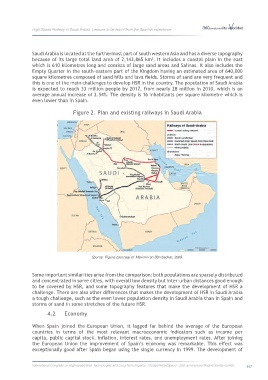Page 519 - 360.revista de Alta Velocidad - Nº 6
P. 519
High Speed Railway in Saudi Arabia: Lessons to be learnt from the Spanish experience
Saudi Arabia is located at the furthermost part of south western Asia and has a diverse topography
because of its large total land area of 2,143,865 km . It includes a coastal plain in the east
2
which is 610 kilometres long and consists of large sand areas and Salinas. It also includes the
Empty Quarter in the south-eastern part of the Kingdom having an estimated area of 640,000
square kilometres composed of sand hills and lava fields. Storms of sand are very frequent and
this is one of the main challenges to develop HSR in the country. The population of Saudi Arabia
is expected to reach 33 million people by 2017, from nearly 28 million in 2010, which is an
average annual increase of 2.54%. The density is 16 inhabitants per square kilometre which is
even lower than in Spain.
Figure 2. Plan and existing railways in Saudi Arabia
Source: Figure courtesy of Maximilian Dörrbecker, 2009.
Some important similarities arise from the comparison: both populations are sparsely distributed
and concentrated in some cities, with overall low density but inter-urban distances good enough
to be covered by HSR, and some topography features that make the development of HSR a
challenge. There are also other differences that makes the development of HSR in Saudi Arabia
a tough challenge, such as the even lower population density in Saudi Arabia than in Spain and
storms of sand in some stretches of the future HSR.
4.2 Economy
When Spain joined the European Union, it lagged far behind the average of the European
countries in terms of the most relevant macroeconomic indicators such as income per
capita, public capital stock, inflation, interest rates, and unemployment rates. After joining
the European Union the improvement of Spain’s economy was remarkable. This effect was
exceptionally good after Spain began using the single currency in 1999. The development of
International Congress on High-speed Rail: Technologies and Long Term Impacts - Ciudad Real (Spain) - 25th anniversary Madrid-Sevilla corridor 517

